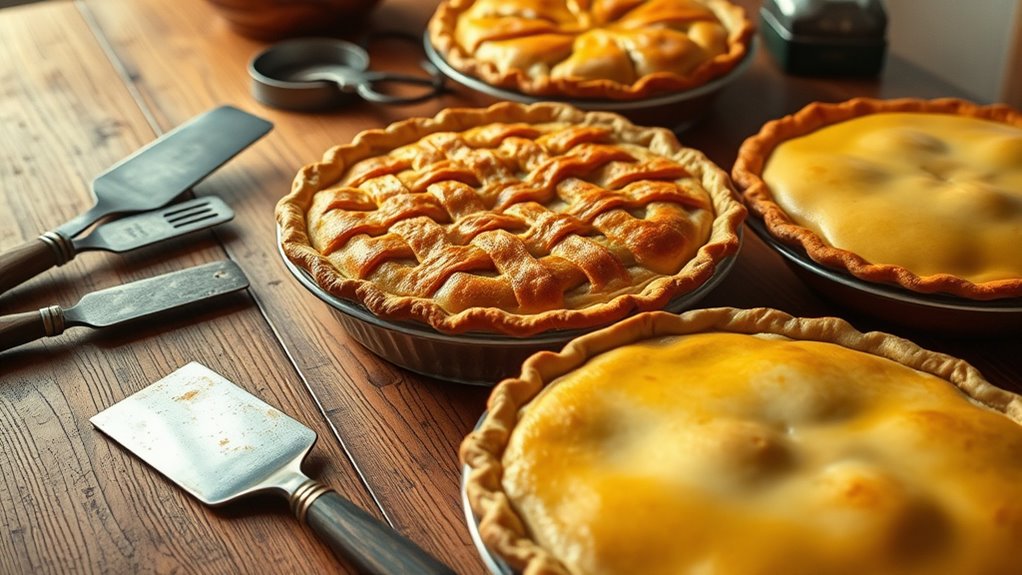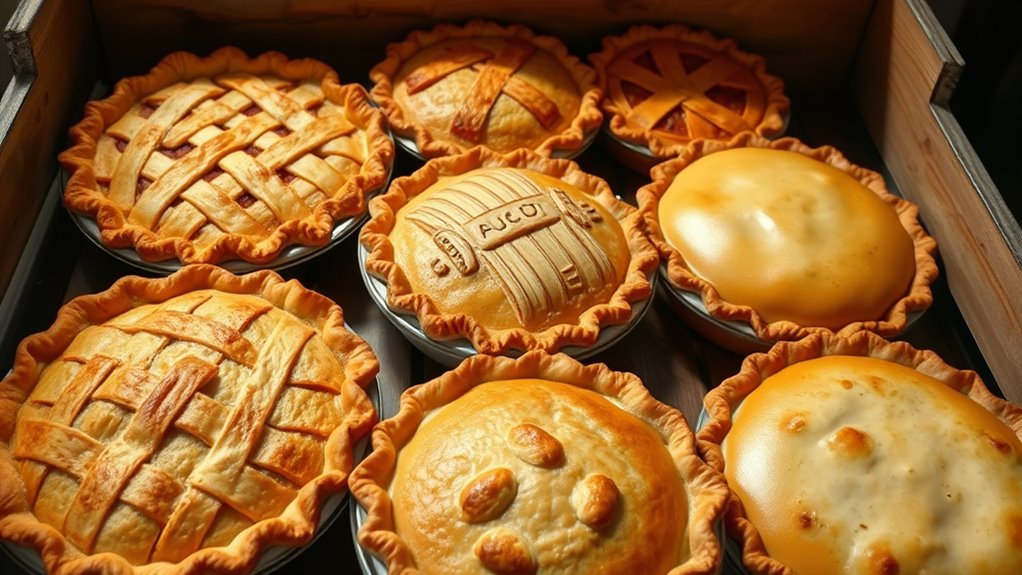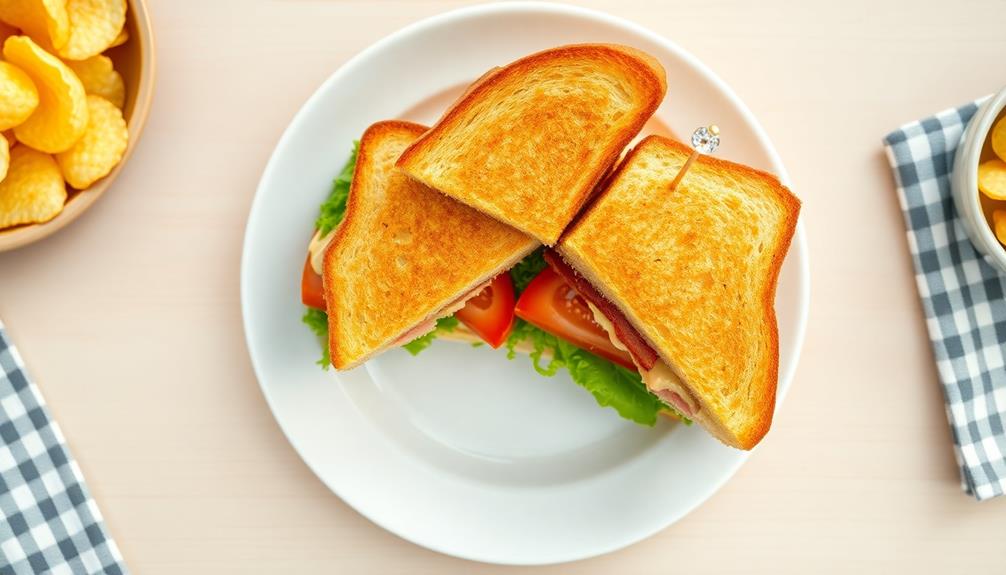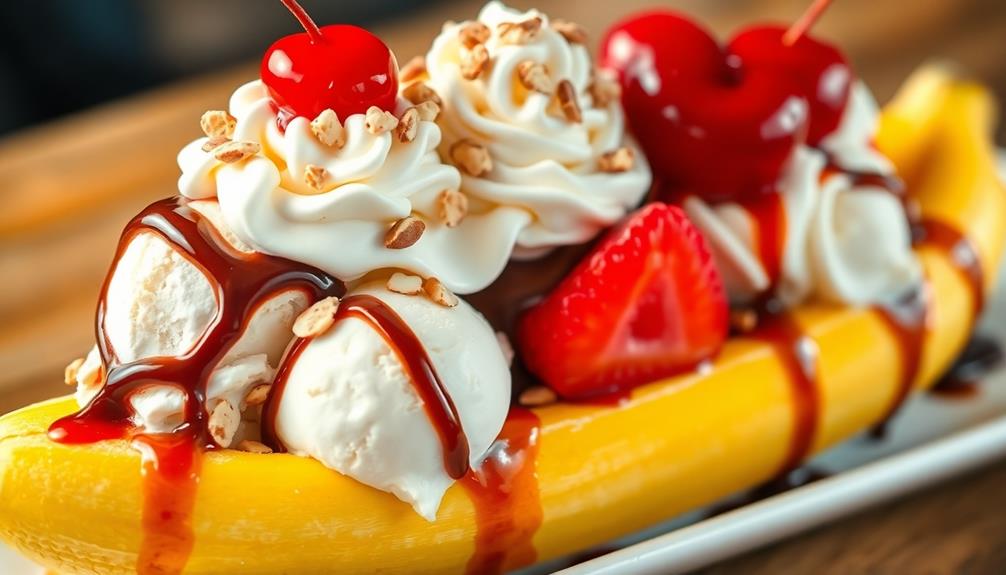The evolution of classic American diner pies shows a shift from using lard for flaky, rich crusts to incorporating shortening for consistency and longer shelf life, reflecting changing tastes and manufacturing needs. Later, butter became popular for its flavor and tender texture, blending tradition with modern preferences. Regional styles also influence crust choices, from thick Midwest pies to delicate Southern varieties. To discover how these methods developed and why, keep exploring this tasty history.
Key Takeaways
- Early diner pies relied on lard for flaky, flavorful crusts, valued for stability and affordability.
- Mid-20th-century shifts introduced shortening to enhance shelf life and consistency in large-scale production.
- Regional preferences influenced crust choices, with Midwest favoring buttery, thick crusts and the South emphasizing flaky, tender layers.
- Incorporation of butter later added richer flavor, blending traditional techniques with modern tastes.
- Technological advances improved precision and consistency, supporting the evolution from lard-based to shortening-based pie crusts.

American diner pies have long been a staple of comfort food, evolving alongside the changing tastes and ingredients available throughout history. One of the most noticeable shifts has been in pie crust methods. Early on, cooks relied heavily on lard, which provided a flaky, flavorful crust that held up well during baking. Lard was accessible and affordable, making it the go-to choice for many home bakers and diners alike. As culinary preferences shifted, so did the ingredients. In the mid-20th century, shortening gained popularity because it offered a more stable, shelf-stable fat that produced a consistent, tender crust. This change allowed diners to streamline their baking processes and produce pies more efficiently, especially in large quantities. Today, many bakers also incorporate butter into their pie crusts, blending traditional techniques with modern tastes for a richer flavor and more nuanced texture.
The evolution of pie crust methods reflects broader regional pie variations across the United States. For example, the deep-dish apple pies of the Midwest often showcase thick, buttery crusts that are hearty enough to support generous fillings. In contrast, the thin, flaky crusts of Southern fruit pies emphasize delicate, melt-in-your-mouth textures. Meanwhile, the New England area is known for its crumb-topped fruit pies, where the crust serves as a sturdy base for layered toppings rather than a flaky shell. These regional variations aren’t just about ingredients—they also reflect local climates, available produce, and cultural influences. Some areas prefer a more robust, pastry-like crust, while others favor a lighter, more tender one. regional pie variations demonstrate how local preferences shape traditional recipes. Additionally, the development of different crust techniques over time has helped bakers adapt to these regional differences and maintain the unique character of each style. The introduction of modern baking tools has further enhanced precision and consistency in crust preparation. Understanding these regional pie variations helps you appreciate the diversity in American diner pies and guides you in selecting the right crust method for your favorite filling. Recognizing how ingredients like lard, shortening, and butter have influenced crust textures can help bakers choose the best option for their specific regional style. Whether you prefer a thick, buttery crust reminiscent of Midwest classics or a delicate, flaky shell like those found in the South, the history of pie crust methods shows how ingredients and techniques have continually evolved to suit regional tastes and culinary innovations.
Frequently Asked Questions
How Did Regional Ingredients Influence Diner Pie Variations?
You notice that regional ingredients greatly influence diner pie variations. Local fruit shapes the flavors, making cherry in the Midwest or peach in the South, while regional spices, like cinnamon or allspice, add distinctive touches. These ingredients reflect local agriculture and culinary traditions, giving each area’s pies a unique character. Your taste buds can often identify a region just by its signature pie, highlighting how regional ingredients create diverse, memorable dessert experiences.
What Role Did Immigrant Cultures Play in Pie Evolution?
You see, immigrant cultures played a big role in shaping pie evolution through cultural influences and ingredient adaptations. They introduced new flavors, techniques, and ingredients like exotic spices or fruits, enriching traditional recipes. These cultural influences led to ingredient adaptations, blending old and new methods to create diverse pie varieties. So, you can appreciate how immigrant contributions helped expand the classic American diner pie palette, making it more flavorful and culturally rich.
Were There Any Health Benefits Associated With Traditional Pie Ingredients?
Think of traditional pie ingredients as a garden; some plants offer sweet sugar substitutes and dietary fiber, like choosing apples over overly processed fillings. While classic ingredients like lard have flavor, modern swaps can boost health by reducing sugar and adding fiber. You benefit from these changes by enjoying pies that satisfy your cravings without compromising your well-being, turning a simple dessert into a nutritious treat.
How Have Modern Dietary Trends Impacted Classic Diner Pie Recipes?
Modern dietary trends have markedly influenced classic diner pie recipes. You now see gluten-free options and vegan substitutions, making these pies accessible to more people. Chefs replace traditional ingredients like wheat flour with alternative flours and swap butter or lard for plant-based fats. These changes allow you to enjoy nostalgic flavors while aligning with health-conscious and ethical eating habits, broadening the pies’ appeal without sacrificing taste.
What Are the Differences in Presentation Between Vintage and Contemporary Diner Pies?
Imagine biting into a vintage diner pie, where dessert aesthetics focus on hearty, rustic charm with flaky, golden crusts and generous fillings. Today’s pies feature cleaner, more refined presentation, with precise crimping and artful toppings. Serving styles have shifted from communal slices on paper plates to individual, plated desserts. You notice these differences as a reflection of changing tastes—more polished and elegant, yet still rooted in nostalgic comfort.
Conclusion
As you’ve seen, American diner pies have come a long way, shifting from lard to shortening to achieve that perfect flaky crust. Each change reflects innovation and adaptation, blending tradition with modern tastes. So, next time you bite into a classic slice, ask yourself: aren’t these pies more than just dessert? They’re a tasty reminder of how history, culture, and creativity come together in every forkful. Isn’t that what makes them truly timeless?









